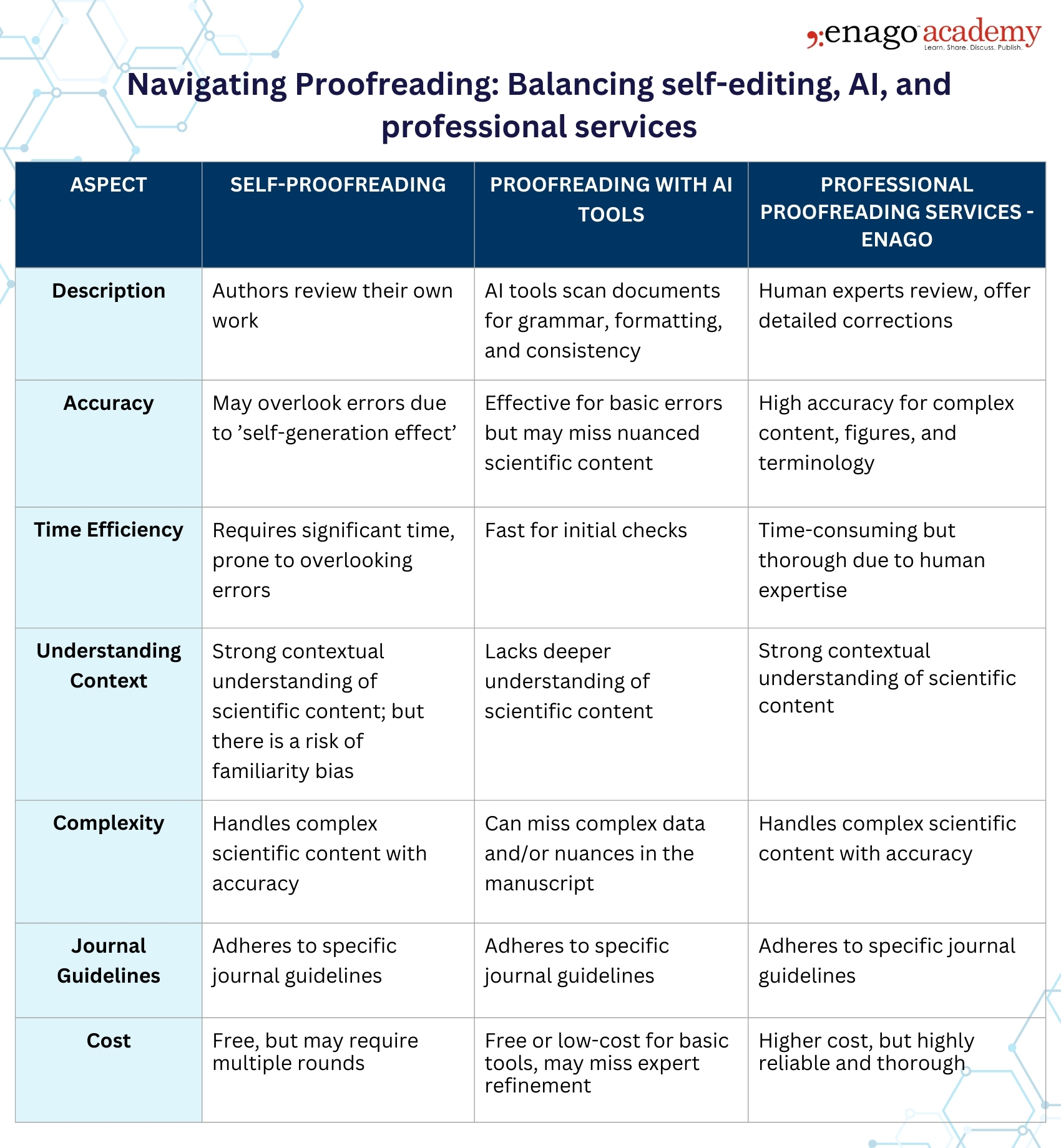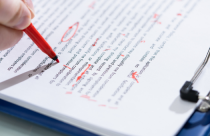Beyond Grammar: Essential proofreading tips for academic writers

Emma, a doctoral student, was about to ask Amy to join her for an outing, but then paused, thinking, “No, I have to proofread an article!” Intrigued, her friend asked what was wrong. Emma explained, “I’ve been working on this paper for months and I need to ensure everything is perfect before I submit it.” Amy nodded, recognizing the importance of thorough proofreading and offered to help her identify common errors in the manuscript.
Common Grammatical Errors to Look Out During Proofreading
 Having combed through the manuscript for these errors and correcting them, Amy wondered what to do with the figures and tables. She decided to check the text and labels in them.
Having combed through the manuscript for these errors and correcting them, Amy wondered what to do with the figures and tables. She decided to check the text and labels in them.
As Amy flipped through the pages again, Emma added, “Proofreading isn’t just about grammar or spelling; it’s about ensuring that the entire manuscript flows seamlessly and is clear, accurate, and coherent. When publishing research findings, even minor inconsistencies and misused terms can question the credibility of your findings and can confuse the readers and/or reviewers.”
Amy nodded, realizing that proofreading includes more than just finding grammatical errors.
Understanding the Concept of Proofreading
Proofreading academic articles require attention beyond the grammatical aspects of a document and varies significantly depending on the type of document.
- Academic papers (research papers and review articles) require meticulous attention to ensure clarity, logical flow, and adherence to journal-specific formatting and citation styles.
- Grant proposals have to be proofread for its precision in presenting objectives, budgets, and methodologies. It should also maintain a persuasive tone to secure funding.
- Technical documents or manuals should be proofread for accuracy in instructions, consistency in terminology, and readability for a diverse audience.
Regardless of the document type, one critical aspect remains universal — ensuring proper attribution of sources. This is particularly important in the context of preventing plagiarism and upholding academic integrity.
Amy leaned back in her chair, tapping her pen on the desk. With a hint of amusement in her voice, she said, “What should I be looking out for in a research article while proofreading?”
Emma smiled and shared a poster with her outlining the checkpoints to look out for while proofreading.
Key Considerations for Proofreading Research Manuscripts

-
Abbreviations and Symbols
Ensure that the acronyms are defined the first time it appears in the text. Provide a table defining them (if necessary). Ensure that the right symbols and units are used consistently in the manuscript.
-
Consistency in Formatting
Check for consistent use of headings and sub-headings. Ensure that the entire manuscript is formatted as per the journal guidelines.
Note: In recent years, most journals have lifted the need to format the article based on the specific journal guidelines during initial submission. However, it is still important to ensure uniform formatting throughout the manuscript as it ensures clarity, readability, and creates a positive influence on reviewers and editors.
-
Literature Review
Ensure the review of existing literature is comprehensive and appropriately cited. A thorough literature review helps you establish the context of your research and the importance of your study.
-
Citations and References
Accurate attribution of the references is absolutely essential in the context of avoiding plagiarism and upholding academic integrity. Ensure that all the sources are cited properly both in-text and in the bibliography.
-
Ethical Considerations
Ensure proper acknowledgment of the authorship, funding, and conflict of interest statements. Clearly mention the approval details, like any specific forms for ethical approval during clinical studies, in vivo studies, etc.
-
Figures and Tables
Ensure that the evidence provided in the form of figures, tables, and videos are not mislabeled, duplicated, or manipulated. Check the accuracy of the statistical data and the calculations to confirm there are no errors in the manuscript.
-
Reproducibility
Ensure that methodology section is clear and comprehensive to allow others in the field for reproducing the findings of your study.
Amy realized that proofreading a research article is different from proofreading a non-academic article as it presents unique challenges and demands meticulous focus on technical precision, and attention to complex data and ideas.
Difference Between Proofreading a Normal Article and a Research Article

Having understood the checkpoints in proofreading a scientific manuscript, Amy leaned forward and said, “It sounds pretty overwhelming. What are some of the biggest challenges that non-native researchers face during in proofreading their manuscript?”
Common Issues Faced During Proofreading One’s Own Research Manuscripts
Over familiarity With the Text
Challenge: Authors often become familiar with their text due to their expertise in the research area or topic under discussion. This familiarity, also termed as the ‘self-generation’ effect, makes it difficult to proofread their own work as they tend to be less objective and overlook the errors.
Tips:
- Take a break before proofreading to gain a fresh perspective
- Read the manuscript aloud to spot errors better
- Ask your peers or mentor to proofread the manuscript to gain a fresher perspective
Addressing Language Inconsistencies
Challenge: Inter-disciplinary and cross-regional research and manuscripts often involve collaborators from diverse technical and linguistic backgrounds, leading to inconsistent language quality, phrasing, and/or terminology.
Tips:
- Standardize language by referring to scientific writing style guides (e.g., APA, AMA, or journal-specific guides)
- Use grammar-check tools or professional editing services to identify language inconsistencies
Adhering to the Deadlines
Challenge: Tight deadlines can lead to the risk of overlooking minor errors.
Tips:
- Allot sufficient time for multiple rounds of proofreading
- Prioritize critical areas like data, methodology, and citations early in the review process
Understanding the Requirements
Challenge: Oftentimes, journals or funding bodies have detailed submission guidelines, and ensuring adherence to these requirements — formatting, referencing, etc. while maintaining consistency throughout a lengthy and complex manuscript can be daunting.
Tips:
- Check the guidelines focusing on formatting, reference style, and word count
- Use citation management tools to ensure proper addition of the references
Emma leaned forward, observing Amy lost in thought. “I get it! Proofreading is tough, especially when we’re too close to our own work. That’s where AI tools and professional proofreading services come in!”
Balancing Self-editing, AI, and Professional Services
 Amy leaned back in her chair and said, “I’ve gained a much clearer understanding now. I see how professional proofreading services like Enago’s proofreading service can help in ensuring that the manuscript aligns with journal guidelines and improves the overall quality in addition to detecting any form of academic misconduct — plagiarism, image manipulation, and statistical errors.”
Amy leaned back in her chair and said, “I’ve gained a much clearer understanding now. I see how professional proofreading services like Enago’s proofreading service can help in ensuring that the manuscript aligns with journal guidelines and improves the overall quality in addition to detecting any form of academic misconduct — plagiarism, image manipulation, and statistical errors.”
Amy stood up, a satisfied smile on her face. “You’re absolutely right. Now that we’ve finished with our work, how about we head out and enjoy the evening?”
With that, they stepped out the door, ready to unwind and recharge!









